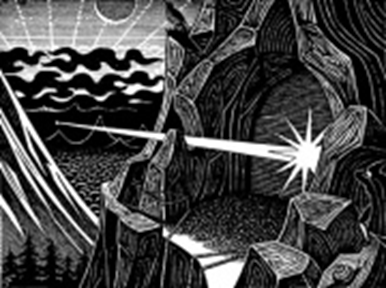

Observing Durin's Day
As we have already learned, the dwarves' New Year falls on the last New Moon of Autumn. In addition, when the sun and moon appear together in the sky on this date (when the moon is less than a full day old) it is termed Durin's Day. We do not know what Peter Jackson's rendition of this important scene at The Lonely Mountain (in the second of the three films) will look like, but here are some other artists' renditions:


Artwork by Anke Eissmann Artwork by Eric Fraser
We also have Tolkien's original design for the dust jacket of the novel (depicted on the main page). Note that there the waxing crescent moon is correctly draw.
While today the Tibetan, Chinese, and the vast majority of Jewish luni-solar calendars strictly rely on calculations to determine the beginnings of their months, the Islamic and Karaite Jewish calendars rely on the actual sighting of the New Moon to determine the start of a month (and hence the beginning of important holidays and festivals). Since the New Moon technically cannot be seen, again, it is actually a very young (and slender and dim) waxing crescent moon that is observed.
Although one can calculate the actual time of New Moon with precision, the earliest possible sighting of a waxing crescent moon is more difficult to predict, as it depends on a number of factors including the location of the moon relative to the sun (itself dependent on a number of factors including time of the year and distance of the moon from the earth) and the observer's experience, visual acuity, and location. Many papers have been written over the past century concerning the earliest visibility of the crescent moon, many based on historical and current observations. The current record for youngest crescent moon seen with the unaided eye is 15.4 hours by J. Schmidt and 15.5 hours by S.J. O'Meara (Schaefer 1988).
Thanks to the accumulation of thousands of observations of young crescent moons (both historical and modern), various computational models have been developed to predict the likelihood of an individual observer being able to view a young crescent of a given age. The Moon Watch program of the Nautical Almanac Office in England (HMNAO) collects observations of the young crescent moon (less than 24 hours old) and continues to refine its computational models. The program also publishes tables of the predicted earliest visibility of the young moon for various cities around the world. One of the most interesting resources they offer is a world map showing the likelihood of any location seeing a less than one-day old moon in a given month. Interestingly, December 13/14 is the dwarves' New Year for 2012 and is the release date for The Hobbit film! It is also technically Durin's Day for at least part of the world (Japan,for example, will be able to see the crescent moon when it is less than a day old)
Since the dwarves have apparently lost the ability to do the calculation, it is presumed that they, too, rely on observations. Too bad they didn't have the Middle-earth version of the HMNAO!
References:
Schaefer, B.E. "Visibility of the Lunar Crescent." Quarterly Journal of the Royal Astronomical Society 29 (1988): 511-23.
To learn more about calculations* of when exactly Durin's Day fell in The Hobbit, see
Harder, Douglas Wilhelm. "Timeline/Chronology for 'The Hobbit'."
Hunnewell, Sumner Gary. "Durin's Day." Ravenhill Special Mythcon XXX/Bree Moot 4 issue, August 1, 1999.
Lalaith. "The Moon and Durin's Day, 2941 TA."
Rateliffe, J.D. The History of The Hobbit Part One: Mr. Baggins (Boston: Houghton Mifflin, 2007).
Rateliffe, J.D. The History of The Hobbit Part Two: Return to Bag-end (Boston: Houghton Mifflin, 2007).
Schaefer, B.E. "The Hobbit and Durin's Day." The Griffith Observer 58 no. 11 (194): 12-17.
* A number of people have asked me what I think the precise date is of Durin's Day in The Hobbit. My answer is that there is no astronomically definitive number because Tolkien erroneously used a lunar phase cycle of 28 days instead of 29.5 days and was not even consistently using this error throughout the novel. We do know that he later realized that there were serious problems with his lunar phases in the work, and although he tried to revise the chronology when working on later editions, was never able to work it all out in a way that was consistent. See John Rateliffe's amazing work listed above for details and my paper "The Lunacy of The Hobbit" Amon Hen: Bulletin of the Tolkien Society, 230, 2011: 20-1.
Enclosed images belong to their respective owners and no copyright infringement intended. The text of The Hobbit and The Lord of the Rings belong to the Tolkien Estate and quotations are enclosed here for educational purposes only. Permission granted to use all original enclosed materials here for educational purposes. Original material written by Kristine Larsen, Central Connecticut State University.